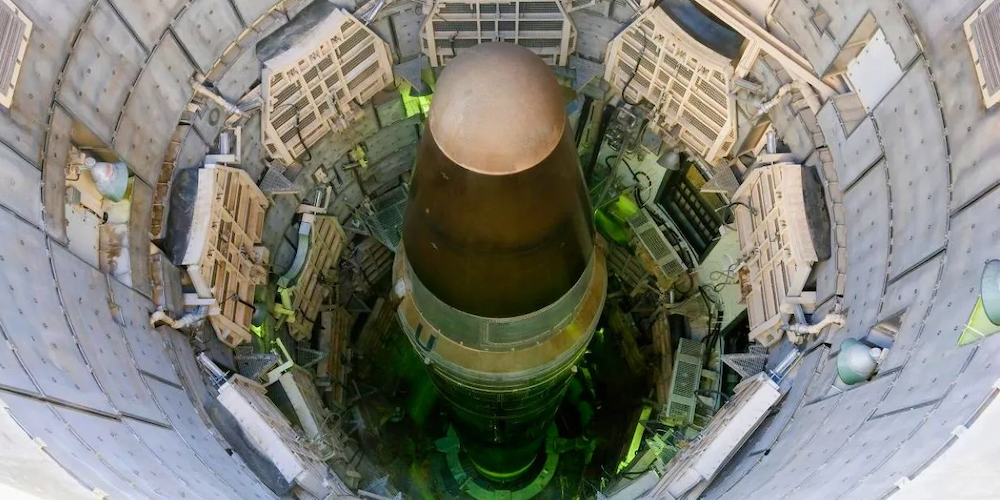RIGHT ANGLE – Goodbye CTBT

India’s opposition to the CTBT ratification is a principled one
By and by, the pillars of global arms control, particularly the agreements between Moscow and Washington, seem to be crumbling. Russia has formally revoked its ratification of the Comprehensive (Nuclear) Test Ban Treaty (CTBT), which prohibits “any nuclear weapon test explosion or any other nuclear explosion” anywhere in the world. The decision has been approved by both houses of the Russian Parliament. The Parliamentary approval was a mere formality since the idea was essentially aired by President Valdimir Putin on October 5.
Washington and Moscow have always accused one another of trying to cheat on various Arms Control measures. And that has resulted in the collapse of the Anti-Ballistic Missile (ABM) treaty in 2002, the Intermediate-Range Nuclear Forces (INF) in 2019 and the Treaty on Open Skies in 2021. Prospects of further extension of the New START that limits their respective number of nuclear weapons in 2026 have also been jeopardized with both Russia and the US stopping inspectors to visit one another, as stipulated for in New START.
Against this background, Russia’s revocation of the CTBT’s ratification is not good news. It does not necessarily mean that Russia is going to conduct nuclear tests now (Post-Soviet Russia has never carried out a nuclear test. The Soviet Union last tested in 1990 and the United States in 1992). But such a possibility cannot be ruled out categorically in future.
If the official explanation of Russian leaders and officials are any indication, Russia’s goal is to achieve parity with the United States in its nuclear capabilities. If the United States resumes tests, Russia will do so. Vladimir Yermakov, head of the Russian foreign ministry’s non-proliferation and arms control department, has been quoted to have said: “Withdrawing ratification by no means undermines our constructive approach to the CTBT and does not mean that our country intends to resume nuclear tests”, adding “Russia would stick to a testing moratorium it declared in 1992. Russia would only conduct a test if the United States did so first”.
According to Nikolai Sokov, a former Russian Foreign Ministry official and arms control expert, “I think that withdrawal of ratification is a strictly political step — leveling status with the U.S….. the main motive is the perception that ‘Russia tried too hard in the past and made too many concessions’ and now ‘We’re not interested in arms control more than other countries.'”
It is significant to note here that Russian decision to reconsider its ratification of the CTBT came in the wake of the US Congress releasing earlier this month “America’s Strategic Posture: The Final Report of the Congressional Commission on the Strategic Posture of the United States”, a lengthy report full of policy recommendations about America’s nuclear weapons.
According to this report, nuclear diplomacy is failing, and the U.S. needs to deter a nuclear war with both Russia and China at the same time. “U.S. strategy should no longer treat China’s nuclear forces as a ‘lesser included’ threat”. Therefore, “the nuclear force structure constructs can no longer assume that the nuclear forces necessary to deter or counter the Russian nuclear threat will be sufficient to deter or counter the Chinese nuclear threat simultaneously. Nuclear force sizing and composition must account for the possibility of combined aggression from Russia and China. Therefore, the United States needs a nuclear posture capable of simultaneously deterring both”, the report added.
Accepting a Pentagon forecast that China’s rapid nuclear arsenal expansion likely will give it 1,500 nuclear warheads by 2035, confronting the United States with a second major nuclear-armed rival for the first time, the 145-page report said that as the Chinese and Russian threats would become acute in the 2027-2035 timeframe , “decisions need to be made now in order for the nation to be prepared”.
It added that the Pentagon is modernizing America’s nuclear forces so slowly that it’s a security risk. “U.S. strategic force requirements were set more than a decade ago and anticipated a significantly more benign threat environment than the one the United States now faces,” the report said. “Therefore, the United States requires an updated strategic posture to address the projected security environment. This is an urgent task that has yet to be acknowledged”, it added.

It may be further noted that since the CTBT was opened for signature in September 1996, ten (10) nuclear tests have been conducted by three of its non-members: India conducting two tests in 1998, Pakistan also two the same year and North Korea six (in 2006, 2009, 2013, 2016, and 2017).
So far, the CTBT has been signed by 187 nations (Somalia is the latest to do so on September 8th) and ratified by 178 . Among those who have signed but not ratified are Egypt, Israel, China and the United States (But they all have abided by the terms of the Treaty of not exploding nuclear devices). The American Senate refused to ratify, citing concerns about verifying other countries. And now Russia will join the ranks.
As mentioned above, among the nuclear weapons –powers who have not signed the CTBT are India, Pakistan and North Korea. India’s reasons for not signing the CTBT are essentially three.
One, India’s traditional opposition to the nuclear weapons related treaties like the NPT and CTBT is that these treaties are meaningless if there is no time bound commitment towards universal nuclear disarmament or a world without nuclear weapons.
Two, the CTBT is a peculiar treaty that does not leave any option for sovereign nations whether to be a party to it or not. Even the United Nations Charter does not compel a country to be a member of the world organization. But under CTBT’s Article XIV, it will not enter into force until it has been signed and ratified by 44 states listed by name in Annex 2. These states include the five original nuclear weapon states—United States, Russia, Britain, France and China—as well as India, Israel, North Korea, and Pakistan.
Viewed thus, it is really odd that if a sovereign country like India is said that it is responsible for non-operationalization of a Treaty like CTBT of which it is not a member in the first place.
Three, though India otherwise has observed the spirit of the CTBT by not exploding any nuclear device after 1998 and its nuclear posture is a very transparent one with promises like NFU(No First Use of nuclear weapons), the quality and quantity of its nuclear arsenal have to take into account the prevailing security environment of the country, an idea akin to the aforesaid US Congressional Report. In fact, many years ago former Atomic Energy Commission Chairman P K Iyenga, who had played an important role in India’s first nuclear explosion in 1974, had told this writer that India’s stated goal of developing a credible nuclear deterrent could not be achieved without further testing. He was not convinced that our nuclear tests in 1998 gave us enough data to develop a credible nuclear weapon system, having accuracy and safety. So, imagine a situation when the Indian soldiers are given untested weapons. One dreads such a prospect, unless the government, in a transparent national debate, comes out with convincing assurances that the country has in its possession credible weaponized nuclear deterrence, he had said.
Even other experts have argued that of the five devices India had tested on May 11 and 13, 1998, three sub-kiloton tests were not good enough for battlefield use. They also are not impressed with India’s claim that its nuclear tests had a thermonuclear device with a thermonuclear device with a yield of 42 kT. Because they think that for any credibility, India’s thermonuclear weapon should have a weapon with a yield in the 100-kT to 1-MT range if it wants to maintain any sort of balance with China.
“Despite the common belief that one atomic weapon is enough to destroy a city, in actuality a 10-kT weapon will destroy about 9 sq km of an urban area. While this yield would be quite enough for a medium-sized city like Hiroshima with a population of about one-quarter million and a built-up area of about 18 sq km, large modern cities typically have populations of 5 to 10 million and built-up areas of 500 to 1,000 sq km or more. A small Indian retaliatory force of, say, ten 10-kT weapons would barely be enough to disable even one large Chinese city (bearing in mind that not every square kilometer of a city must be destroyed before it stops functioning). However, a 1-MT weapon will destroy an area at least 20 times larger than that of a 10-kT one. Approximately 20 Chinese multi-megaton weapons would be enough to disable every Indian city with a population of more than 1 million”, argues Gregory S. Jones of the RAND Corporation.
This debate over whether India needs more tests or not is likely to be more rigorous now, given the changing thinking of both the US and Russia over the CTBT. CTBTO (CTBT Organization) Executive Secretary Dr Robert Floyd has said in a press interview that as CTBT is said to be not addressing several core concerns raised by India, “We are very keen to have a dialogue with India about the CTBT. It is something I would dearly love to have. India can explain its position to me clearly and then we can look at how to move forward from there”.
However, it is going to be a challenging task now that Russia is withdrawing from the CTBT, and the USA does not show any promise of ratifying the treaty after signing it 27 years ago.


